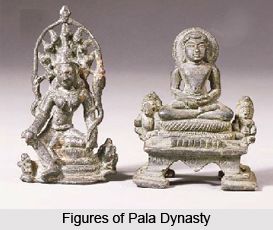 Nalanda an ancient seat of Buddhism learning and science in India, lost all the prominences after the demise of Harshavardhana and its empire. Later on, the Palas emerged in Bengal and patron Nalanda and built several monasteries like Moghulmari and Odantapuri.
Nalanda an ancient seat of Buddhism learning and science in India, lost all the prominences after the demise of Harshavardhana and its empire. Later on, the Palas emerged in Bengal and patron Nalanda and built several monasteries like Moghulmari and Odantapuri.
Establishment of Pala Dynasty
Pala Dynasty established them in North-eastern India in the 8th century and reigned until the 12th century. Although they were a Buddhist dynasty, Buddhism in their time was a mixture of the Mahayana practised in Nalanda and Vajrayana, a Tantra-influenced version of Mahayanist philosophy.
Partial Decline of Nalanda
Nalanda during Pala era was a cultural legacy from the great age of the Guptas and it was prized and cherished. The Palas were prolific builders and their rule oversaw the establishment of four other Mahaviharas modelled on the Nalanda Mahavihara at Jagaddala, Odantapuri, Somapura, and Vikramashila respectively. Remarkably, Odantapura was founded by Gopala, the progenitor of the royal line, only 6 miles away from Nalanda.
Inscriptions in Nalanda
The inscriptions at Nalanda suggest that Gopala`s son, Dharmapala, who founded the Mahavihara at Vikramshila, also appears to have been a benefactor of the ancient monastery in some form. It is however, Dharmapala`s son, the 9th century emperor and founder of the Mahavihara at Somapura, Devapala, who appears to have been Nalanda`s most distinguished patron in this age. A number of metallic figures containing references to Devapala have been found in its ruins as well as two notable inscriptions. The first, a copper plate inscription unearthed at Nalanda, details an endowment by the Shailendra King, Balaputradeva of Suvarnadvipa (Sumatra in modern-day Indonesia). This Srivijayan king, attracted by the manifold excellences of Nalanda had built a monastery there and had requested Devapala to grant the revenue of five villages for its upkeep, a request which was granted. The Ghosrawan inscription is the other inscription from Devapala`s time and it mentions that he received and patronised a learned Vedic scholar named Viradeva who was later elected the head of Nalanda. While there is ample epigraphic and literary evidence to show that the Palas continued to patronise Nalanda liberally, the Mahavihara was less singularly outstanding during this period as the other Pala establishments must have drawn away a number of learned monks from Nalanda.
Vajrayana Influence on Buddhism
The Vajrayana influence on Buddhism grew strong under the Palas and this appears to have also had an effect on Nalanda. What had once been a centre of liberal scholarship with a Mahayanist focus grew more fixated with Tantric doctrines and magic rites. The 17th-century history claims that Nalanda might have even been under the control of the head of the Vikramshila at some point.



















